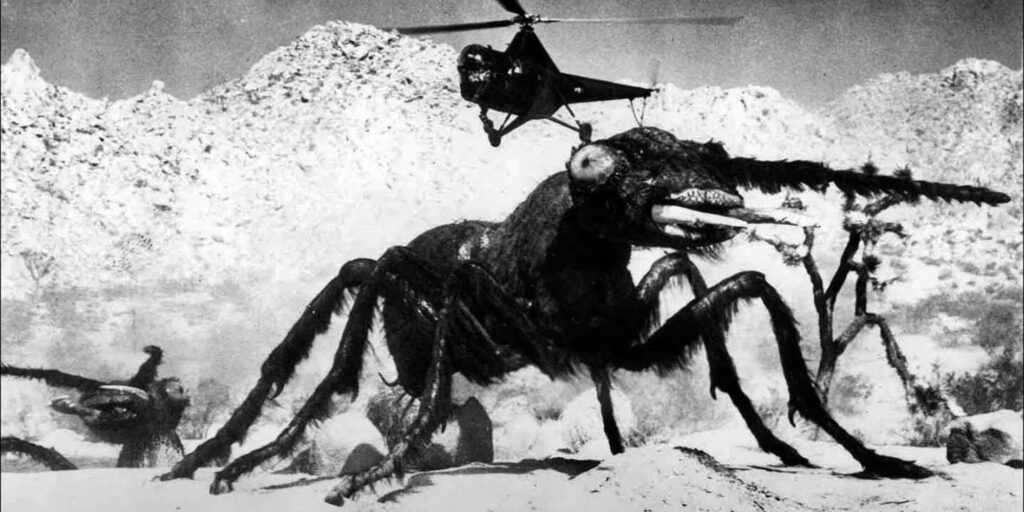It’s Creepy Crawlers month here at Horror Press, and while there may be something creepier, there’s certainly nothing crawlier than one of my favorite subgenres of the 1950s: the giant nuclear bug movie. Name a creepy crawler. An insect, an arachnid, four legs, six legs, eight legs, a hundred… If it exists, somewhere in 1950s cinema it has been irradiated, grown to terrifying size, and crushed puny little humans beneath its mighty, composited feet. On this month’s Horror 101, we’re here to give you a quick and dirty breakdown of the who, what, and why behind this towering titan of science fiction tropes.
Why Were 1950s Sci-Fi Movies Obsessed with Radiation?
Wouldn’t you be obsessed with radiation if you were living in the years after the atomic bombs were dropped on Japan at the end of World War II? Sure, in America, plenty of people at the time were pretty pleased with themselves about said atrocity. But those concerns were nevertheless ever-present. Did the testing we performed to put the bomb together already plant the seed of our own destruction in our soil, water, and DNA? Will other countries pick up on what we did and, in return, split the atom on our smug asses? These fears have carried on into the modern era, of course, but the ongoing Cold War stoked those tensions to a fever pitch in the 1950s.
It might seem unlikely that people flocked to see movies about scientists tampering in God’s domain and having their nuclear testing go wrong and bite them in the ass. Or the torso. Or the head. However, like many a good horror movie, those giant nuclear bug titles provoked a reaction by playing into those fears, only to have the intrepid heroes solve them, neutralize the threat, and probably mack on a sexy lady scientist at some point in the process. Or, more likely, mack on a sexy lady who’s the daughter of a scientist – the 1950s weren’t exactly a haven of progressive virtue.
Whatever the case, those movies poke at the wound a little bit, only to bandage it up and tie a little bow around it by the end. They offered the same cathartic experiences as horror stories throughout time, allowing audiences a glimpse into their deepest fears just long enough for them to begin to cope with them.
What Are Some Key Giant Nuclear Bug Movies?
Them! (1954, dir. Gordon Douglas) – Them!, which follows giant ants rampaging around New Mexico, isn’t fucking around. It literally ends with a character more or less staring into the camera and wondering what other horrors the Trinity test and ongoing nuclear testing may have unleashed that we are as yet unaware of.
Tarantula (1955, dir. Jack Arnold) – Arnold didn’t direct too much else under the giant nuclear bug territory, but he did helm It Came from Outer Space, Creature from the Black Lagoon, and The Incredible Shrinking Man, so when he talks, you listen. The titular tarantula that took to the hills has been embiggened thanks to tests attempting to use a radioactive element to create an artificial super-nutrient, showcasing how even the best intentions can lead to destruction and chaos. Oppenheimer who?
Beginning of the End (1957, dir. Bert I. Gordon) – This schlocky but entertaining venture follows USDA testing of radioactive fertilizer causing a cloud of giant locusts to tear their way through Illinois. Keep an eye on this Bert I. Gordon fellow. The notorious B.I.G. made plenty of giant movies, nuclear movies, and bug movies, though not always at the same time, including King Dinosaur (1955), The Cyclops (1957), The Amazing Colossal Man (1957), War of the Colossal Beast (1958), The Spider (1958), Village of the Giants (1965), The Food of the Gods (1976), and Empire of the Ants (1977).
Monster from Green Hell (1957, dir. Kenneth G. Crane) – The giant wasps here are exposed to cosmic radiation. I’ve decided that this premise does count for the list, because even though our scientific hubris didn’t come from exposing the wasps to radiation on purpose, we still sent wasps up to space in the first place, which seems like a silly idea if you ask me.
Mothra (1961, dir. Honda Ishirô) – OK, the Japanese monster movie Mothra is a little outside the scope of its study for multiple reasons, not the least of all being its year of release. However, it does involve a giant nuclear moth who defends her remote island home against further nuclear testing. The combination of gentleness and power at the center of both the story and the titular figure in Mothra is a beautiful button on a decade of tension and dismay, offering a way forward beyond mere catharsis.
For more giant bug fun without the “nuclear” part, see The Black Scorpion (1957), The Deadly Mantis (1957), and The Spider (1958). For a giant nuclear octopus, see It Came from Beneath the Sea (1955). For a non-giant nuclear teenage werewolf, see I Was a Teenage Werewolf (1957). For the granddaddy of giant nuclear monsters, see Honda’s previous monster movie Godzilla (1954), which of course was already a riff on the giant nuclear dinosaur movie The Beast from 20,000 Fathoms (1953).
Looking to expand your horror knowledge even more? Check out our other HORROR 101 articles here!
